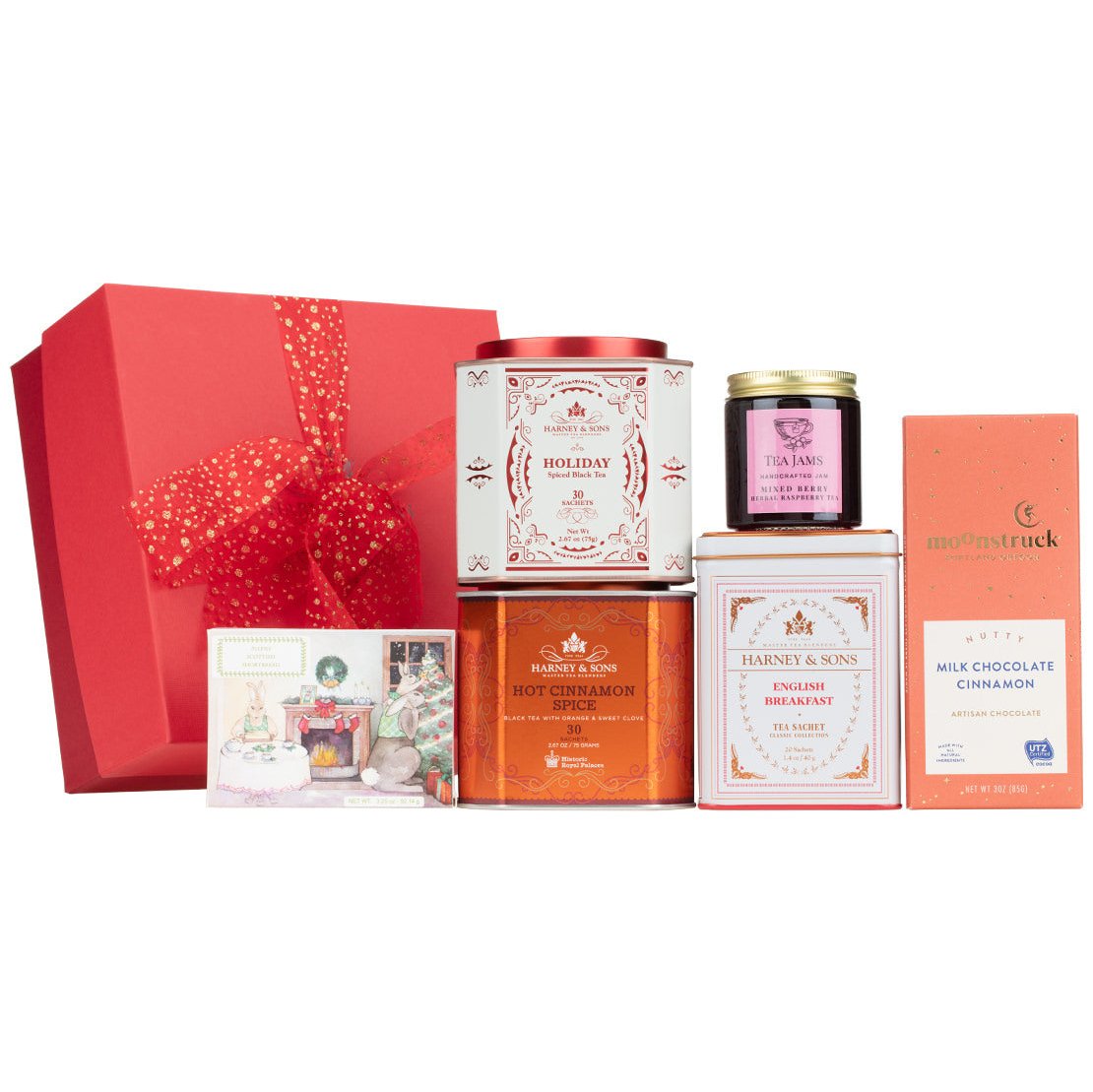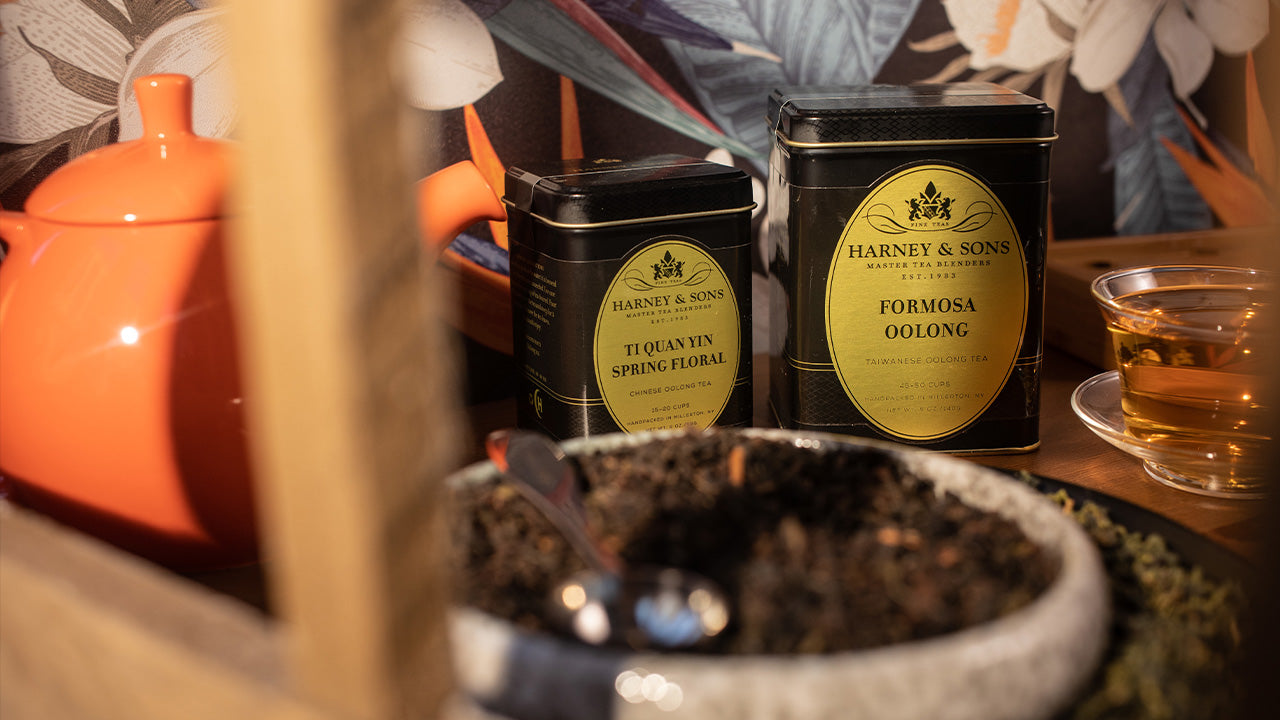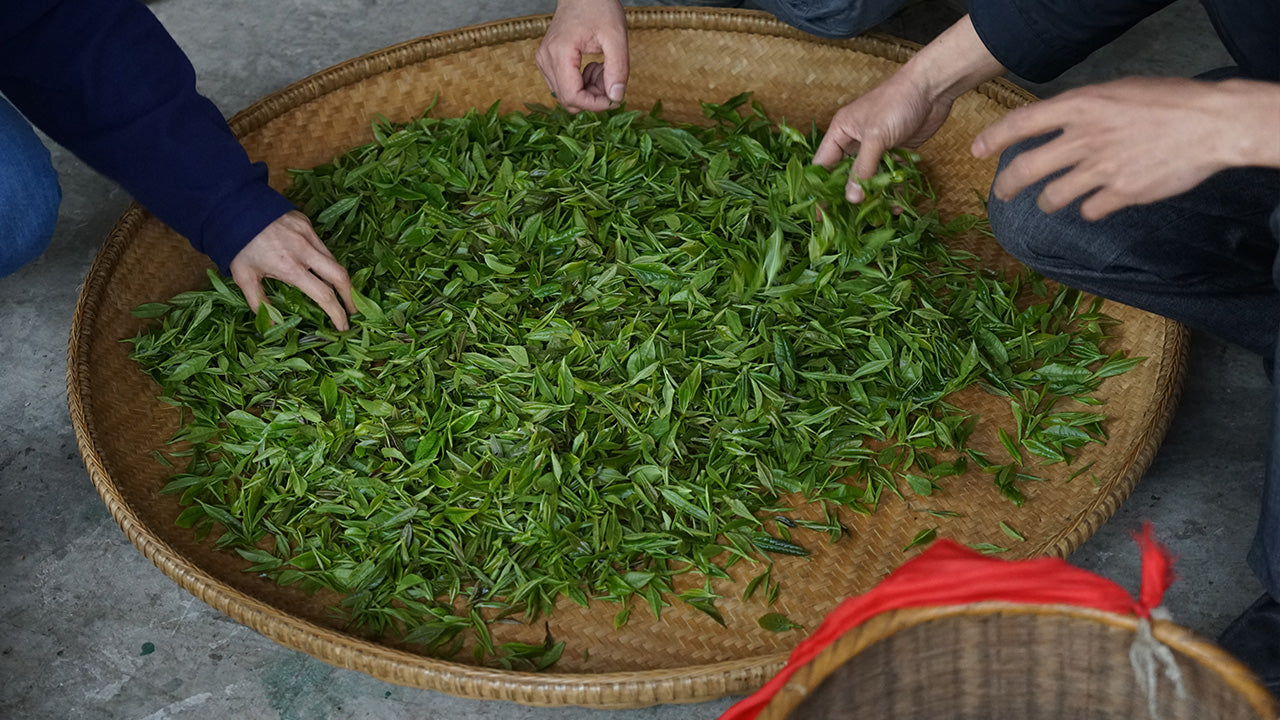Fans of oolong tea understand that there is much to love about this brilliantly complex tea. Let’s dive into this singular tea and learn what makes an oolong unique, discuss how oolong tea tastes, discover the benefits of oolong tea and more. So let’s get moving oolong, shall we?
How Oolong Teas Are Made
Oolongs bridge the divide between green and black teas. As always, oxidation is a key factor. In our Types of Green Teas blog, we learned that greens keep their color because they are not oxidized, while in our Types of Black Teas blog, we learned that oxidation is the key differentiator between the color and flavors of black and green teas. So if green teas are not oxidized at all, and black teas are 100 percent oxidized, oolongs range from 10 to 75 percent. Here’s why (and how).
Oolongs oxidize more slowly than other teas. As a result, they have the most complex, mellow flavors. Oolongs start to oxidize when they wither because tea makers gently fluff the leaves on tarps in the sun. This fluffing qualifies as a very light rolling, triggering oxidation along the edges of the leaves. This gentle agitation is what gives oolong leaves their characteristic red tinge.

After withering, the leaves are rolled incrementally in an elaborate stop-and-start oxidation that lasts for six hours or more. This gradual oxidation prolongs the withering, allowing for the creation of yet more aromatic compounds. The final flavors and aromas depend entirely on the amount of time the oolongs are given to wither and oxidize. Some oxidize roughly 25 percent; lower oxidation produces citrus and floral aromas of lime, jasmine and gardenia. Higher oxidations of 40-75 percent develop more apricot and peach flavors.
In many respects, oolong teas are the most complicated to make because of this partial oxidation process. Hard work, however, always pays off.
How Oolongs Teas Taste
Oolongs take on an astonishing array of flavors and aromas. A light oolong can taste like a walk through a garden packed with lilacs, gardenias and jasmine. A darker oolong can smell like a bakery right after it’s finished a round of peach pies. From the cultivar Camellia sinensis, and their singular methods of production, oolongs take on an astonishing array of flavors and aromas. Many oolongs are creamy, their liquor coating your mouth like fresh cream. Others are almost effervescent, practically fizzing like champagne. Their variety of colors is lovely to behold, from the pale greenish-yellow liquor of Ti Quan Yin (also known as Ti Guan Yin or Iron Goddess of Mercy) to the dark orange brew of Fenghuang ShuiXian.
Benefits of Oolong Teas
Research is increasingly revealing the many health benefits of tea, and oolongs are no exception to that. Oolong teas, in particular, have been anecdotally associated with possible increased metabolism and weight loss. Other possible health benefits include boosting heart health, improving cognitive function, raising digestive tract health, reducing inflammation and helping lower stress levels.
Types of Oolong Teas
We carry three different categories of oolong teas, each having their own unique characteristics.

Oolong likely first appeared within the last three to four hundred years in China’s Fujian province, in the Wuyi Mountains. Presumably frustrated with the quality of their green teas, tea makers there found something to catch the attention of the emperor’s tribute board when they decided not to fix their green teas but to let them wither and darken to black tea. Later, they figured out how to halt the oxidation by degrees, making the teas ever lighter in color. The results were magical.
- Traditional Ti Quan Yin. Ti Quan Yin is one of the most heralded oolongs in the world and is one of the few teas said to be divinely inspired. Its creation myth holds that a farmer was renovating a temple to the Buddhist deity Guan Yin, a female bodhisattva of compassion, when her iron statue came to life. To thank him for cleaning her temple, she told him his fortune would be found in the fields right outside. There the farmer found a tea bush and named the tea he made with it after her. It is a golden yellow with floral gardenia notes along with the fine, creamy sweetness of buttered white toast and a finish of cooked sugar like cotton candy.
- Osmanthus. A native to China, the osmanthus flower is apricot-scented with a yellow orange hue. While some of this tea’s apricot flavors come from the tea leaves, most come from the slender strands of dried osmanthus blossoms. Osmanthus is a delightful, muted dark oolong, lovely for everyday drinking.
- Wuyi Da Hong Pao. Da Hong Pao is also known as Big Red Robe (We added “Wuyi”, the region this tea comes from, to the name to differentiate it as a higher quality Da Hong Pao), this famous Chinese oolong resembles the oolongs of a few decades ago, heavily fired and with darker, smokier flavors. Fans of the smoky Chinese black tea Lapsang Souchong or the charcoal-tinged Chinese green tea Gunpowder will find much to love in a Da Hong Pao. Along with its smoky yet sweet aroma, you can expect to taste peach compote sweetened with brown sugar or even molasses, with a similar dark edge in the finish.

Oolong teas made their way from Fujian to Taiwan, which lies directly across the Taiwan Strait from Fujian. Over half a century ago, Taiwanese oolong producers chose to capitalize on the benefits of vacuum packaging and air shipping so that they could do away with the heavy firings once required to preserve and transport teas. This created oolongs of terrific lightness and nuance.
- Formosa Oolong. This tea was once considered the Champagne of teas and the standard for oolongs in the U.S. In recent decades, however, lighter and more aromatic oolongs have outpaced it so that today it is made by only a handful of Taiwanese tea makers. We use it as a base in our Earl Grey tea and other blends that call for a mild, dark oolong. It has flavors of toasted walnuts and some sweet vegetal notes of roasted carrots.
- Fanciest Formosa Oolong. Also known as Bai Hao, this tea is extraordinary not only for its flavors, but for the way it is made. Most teas rely on human manipulations to develop their flavors. These manipulations imitate the actions of tiny herbivores called green leafhoppers, which would ordinarily feast on the leaves. In nature, the bites of tea leafhoppers trigger the plants’ defense, provoking their flavors. Bai Hao is one of only a very few teas whose flavors are provoked by the bugs themselves. The leafhoppers feast on the tea’s sweet young leaves, puncturing them lightly. Their munching breaks down the plants’ cells in the same way rolling does, releasing various bug-repelling, flavor-filled compounds. This is how Bai Hao produces its wonderful peachy aroma and taste. We know, right?
- Dong Ding Light. Dong Ding is a lovely example of a creamy, lemony oolong. It is Taiwan’s most famous and beloved oolong and most likely its first. It is grown within view of the snow-peaked Dong Ding Mountain. This tea is oxidized for less time than other Dong Ding teas, hence the addition of “Light” which has nothing to do with fewer calories because it has none!

Yes, oolongs have plenty of flavor on their own…so why not enhance it with unique flavors to put a spotlight on their inherently wonderful qualities.
- Ginger’s Oolong. Our Peaches & Ginger is a popular black tea blend, so we thought, “Formosa Oolong has peach notes, let’s add some ginger root.” Voilà! The subtle flavors of peaches and toasted nuts are nicely contrasted by the ginger and puts out an enticing spicy aroma.
- Milky Oolong. Milky oolongs are very popular in Eastern Asia for their sweet, creamy flavors. Ours is smooth, and the aroma of warmed cream is delicious! Much like many people ask if our best-selling Hot Cinnamon Spice has added sugar (it doesn’t, we swear!), this tea is so creamy you’ll think it has milk in it. But it doesn’t. Must be magic!
- Pomegranate Oolong. Our Pomegranate Oolong tea blends large Ti Quan Yin leaves with the tangy, sparkling flavor of pomegranate. The result is a luscious and fruit-forward brew with a toasty aroma and ample flavors of bright pomegranate. Brew hot to enjoy its smooth, silky texture and sweet aroma at its finest.
You can discover even more about the wonderful world of oolong teas on our Oolong Teas 101 page, including caffeine levels, brewing techniques, recipes, and more. Hopefully, you’ll be enjoying a delicious cup before oolong!
















